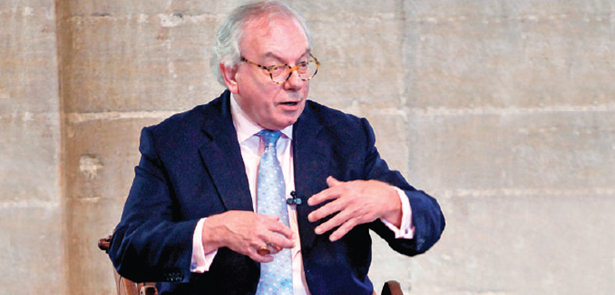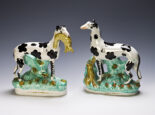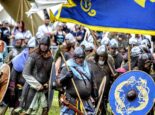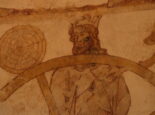David Starkey: “It’s history interacting with now…”

On Saturday 10 September 2016, Dr David Starkey delivered a short address in the Knights’ Chamber on the occasion of the opening of the new Cathedral Visitor Centre. Here is the text of that fascinating speech in full...
It is a very great pleasure to be here but slightly embarrassing to be explaining to those who are so immediately involved in the running of the Cathedral, to those of you who worship here and to those of you who are so familiar with it … it seems to me to be just short of an insult to be explaining to you why I think it’s important. It’s important in your lives, it’s visibly important to the city. But I’m going to take a different approach, and I think it’s particularly appropriate as I am going to open the Heritage and Learning Centre: I am going to look at the building in terms of its history. It’s history interacting with now. Inevitably all history is also a commentary on the present.
Peterborough, at the centre of debate
The great issue which is convulsing the country now, not that you would really know it, is called Brexit. It’s the whole debate about what we are, where we’re from, where we’re going. Peterborough is, and always has been, at the centre of this debate. As you go round the Visitor and Learning Centre you will see that one of the key things that happened here (though you no longer have the text) is the Anglo-Saxon Chronicle. Peterborough is the very origin of Englishness, of an idea of England which curiously enough existed first in the Church of England: there is a Church of England, an Ecclesia Anglicana, before there is an actual Kingdom of England. The Anglo-Saxon Chronicle is partly mythic. It goes right back to Hengist and Horsa; it’s an exploration of origins. It’s an attempt of an immigrant, warring community to explain where it came from, where it’s gone to and what it’s becoming. That is what the Chronicle is about.
The Anglo-Saxon Chronicle
I think you should be pushing the Chronicle much, much more and there is an extremely solid case, now that you have copies, or part of one of the copies, exhibited here. If we are talking about the return of the Book of Kells and so on etc, Peterborough, that is where the it belongs, that is where it was written, that is where it kept on being written after that enormous challenge to that sense of identity, which was of course the Norman Conquest. The English became a colonised and conquered people in their own land and the Chronicle which was written here tells that story with bitterness, with regret, with a sense of punishment for sin, and with a hope for a better future, all here.
So that is a foundation of a story – the whole process, then, is of the reinvention of a sort of England to bridge the gap between the Norman conqueror and the Anglo- Saxon conquered, which had already begun when the younger son of the Conqueror, Edward I, deliberately marries an Anglo-Saxon princess so that the old royal line can be introduced into the new royal line. By the time you get to 50 years on, and the ceasing of the Anglo-Saxon Chronicle in 1154 (and the time of Magna Carta, again associated with Peterborough), it is the time Norman French barons call themselves English and claim the rights of Englishmen.
A new identity
This is a new fashioned identity, which is again a difficult and awkward story – earlier I was asked about the crusades, which was one way in which identity was fashioned and knit together – the other, of course, was fighting the French. The best way of identifying yourself as being English, still, is to go and fight the French. Peterborough was also at the centre of the even greater challenge, a religious one as well as a national one. I always say, if I’m being a tad more provocative than usual, that there is a direct line from Henry VIII to Nigel Farage. The Reformation is the first Brexit. This cathedral, with the tomb of Katharine of Aragon, is literally the crucible of that process. The reason the Reformation happens is, first of all, Katharine’s failure to produce a son. But above all, and what we’ve forgotten, is that this is not the final trigger. It is her refusal to give up on her marriage.
The Aragon Connection…
As she lies dying at Buckden, so near to here, she has a long exchange with the Imperial Ambassador, Chapuys, and she says to him, I have sinned because it is my obstinacy that has led to the schism, the heresy of an entire country. Chapuys says, no no madam. But she was right. So here again we have this extraordinary process of debate about identity and reinvention of identity. Ladies and gentlemen, the Reformation is the beginning of an idea of England separate from Continental Europe. The Norman Conquest turns England round. The England of the Anglo- Saxons, the England of Peterborough, the England of York looks across the north sea to Scandinavia. The Norman Conquest turns England round and it meant the Channel was merely a very convenient means of communication.
Much conquered
Remember, there is a total myth that we were protected from conquest by the Channel. Because we had no powerful coastal fortifications, because we had no powerful navy, England was perpetually conquered in the middle ages. Every change of dynasty, including the Tudors, is a foreign conquest. Do we all realise, Henry VII at Bosworth: his money was French, his ships were French, his army was French, his tactics were French and the entire diplomacy was French and the only person to get a peerage out of it was a Frenchman. But what happens to Henry VIII and the Reformation is something widely different. The break with Rome is literally fought over the same grounds of sovereignty that we have been debating in the last two or three months. The moment becomes clear even before poor Katharine is dying.
The power of Parliament
The moment is clear with the trial of Thomas More. Thomas More is on trial for his life for denying that Henry VIII could make himself, by an Act of Parliament, Supreme Head of the English Church. He is found guilty, of course by rigged evidence from Richard Rich – ‘For Wales Richard for Wales’. In the debate at Thomas More’s trial which follows his conviction, it is extraordinary how it touches the present. Invited to comment on his condemnation More says, my condemnation is illegal (and he is the greatest lawyer of his day). He said, my condemnation is illegal because the Act of Parliament on which it is based was ultra vires (beyond the power of parliament). He then goes on and says, the English Parliament is only a parish council.
It is the part, not the whole. It is part of Christendom and the universal council of Christendom is the General Council of the Church, and the part cannot rebel against the whole. And it’s settled brilliantly by the chairman of the court, the Lord Chief Justice responds magnificently, with words that will gladden the heart of every sincere Brexiteer, it is an Act of Parliament: it is good enough. It is exactly the debate we’ve been having. Katharine of Aragon is the trigger of the direct terms of that debate.
A battle of beliefs
What is then built of course is the transformation of a Benedictine monastery, brilliantly described and documented, as it becomes an Anglican Cathedral. But it also reminds me, if you look at Henry VIII’s Charter of Foundation displayed in the Visitor Centre, that what is conceived is a real cathedral, with a choir, with a school, with endowed offices within it. In other words, there ain’t a trace of Protestantism about it at all. But then what happens in the centuries after that is that the nature of English Protestantism and the nature of the Church of England, and therefore the nature of Englishness, is fought over exactly that point. You have the famous description of the Cathedral being sacked by Cromwell – what is the first thing they destroy as they go into the Cathedral? The organs. If you watch my TV series Monarchy (and I’m sure you all will have done), or read my book, the civil war is a war about organs, it is a war about cathedral music. It’s a war about the idea that God can be worshipped with other things than words, and should be worshipped with other things than words, and that of course there is an entire debate about identity. Are we simply the people of the book or are we a people of a broad and European culture? See what I mean?
A living monument to history
So that at every single point in the history of this building, in its great moments, in the great objects, the tombs and so on within it, there is a reflection, a kind of match struck in the dark that illuminates our present, illuminates our own debates and discussions. We were talking earlier about the possibility that a member of the choir could be a Muslim – a thought that still strikes me as almost incomprehensible – but is clearly part, not of multi-culturalism but a new kind of bi-culturalism in which you can be English and something else, and that both matter, just as they did of course to the Anglo-Saxons and to the Normans, to Henry VIII and everybody at that time. What we forget is that it was not only Shakespeare who was of Catholic background. Every English Protestant was a betrayed Catholic. They had all gone through a revolution in their own lives; history isn’t comfortable. This building is beautiful, this building is noble, and finally this building tells a story of conflict and of debate, one that has absolutely no end.
Peterborough Cathedral timeline
DESTRUCTION AND RENEWAL
410 ROMAN LEGIONS LEAVE BRITAIN Followed by the arrival of Anglo- Saxon invaders and settlers.
597 ARRIVAL OF ST AUGUSTINE With 40 monks sent by Pope Gregory the Great who introduced Christianity into England.
654/5 THE ABBEY OF MEDESHAMSTEDE IS FOUNDED by Saxulf, with support from Paeda, King of the Middle Angles ST AETHELWOLD RE-FOUNDS THE ABBEY, ABOUT 972 In about 972, the Abbey was re-founded in a widespread revival of monastic life. With generous backing from King Edgar, this revival was led by Aethelwold, Bishop of Winchester, and Dunstan, Archbishop of Canterbury. The new Abbey was built in stone, and its foundations still lie beneath the present Cathedral. The life of the community was ordered by the Rule of St Benedict. It became known as ‘Bugh’.
ABOUT 1506 New building added by Abbot Robert Kirkton to provide processional space around the east end of the High Altar.
1536-39 MONASTERIES SUPPRESSED BY HENRY VIII and his Vicar-General Thomas Cromwell following the formation of the Church of England. In 1539 Peterborough Abbey surrenders to the King’s Commissioners. Most of the monks are sent away with a pension.
1536 KATHARINE OF ARAGON First wife of King Henry VIII, dies at Kimbolton and is buried in the Abbey.
David Starkey spoke in more depth about Peterborough past, present and future to The Moment exclusively, here















